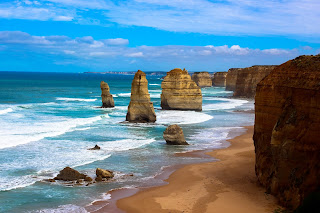16.01.2013
As much as we didn't want to leave the mesmerising Johanna Beach, we got up early on Day 10 as we had so many sites to see. We were continuing our journey along the beautiful Great Ocean Road towards some of Victoria's most famed natural landmarks.
Our first destination was the most famous of them all, the Twelve Apostles which form part of the spectacular Port Campbell National Park. When visiting the site, you are bluntly warned of two dangers here; snakes and unstable cliffs! To quote the sign, "You may fall and DIE." This didn't deter us and you will be pleased to hear we didn't encounter any dangerous reptiles (on this occasion, but we do see a snake later on in the trip!) or fall down any cliffs.
If you aren't aware, the Twelve Apostles are a collection of limestone stacks located on the coast near the Great Ocean Road. They are formed by erosion caused by the rough sea conditions experienced in the Southern Ocean. The basic process is that the sea erodes the soft limestone rock to form a cave, which continues eroding to eventually become an arch, which over time collapses to leave a giant stack of rock which can be up to 45 metres high. It is ongoing and there are still many caves and arches lining the Victorian coastline which have yet to collapse.
Despite originally being called the Sow and Piglets (our next stop, the Loch Ard Gorge, was the Sow and theses stacks were the piglets), the site was renamed in 1922 for tourism purposes even though there have only ever been 9 stacks not 12! In 2005, a 50 metre high stack collapsed and another followed in 2009 meaning there are now only 7 left - and with an erosion rate at the base of the pillars of 2cm a year, more will tumble. However, the waves continue to batter the coastline and more stacks will form in the future.
As they are now, the stacks are breathtaking and it a very special place to visit. Being another hot & sunny day, we had magnificent blue skies as a backdrop to this beautiful coastline. Along with the other visitors there, we stayed for a while just to soak up the beauty and atmosphere. I would return here in a heartbeat and recommend any visitor to Australia to make the journey if they can!
Having loved every second of the 'piglets', we were equally as excited to see the 'Sow' - or Loch Ard Gorge as it is known today. You learn about it's history on the signs scattered around the gorge. The site was named after a ship called Loch Ard, which ran aground nearby in 1878 after a 3 month journey from England to Melbourne. Only 2 of the 54 people on board survived; a 15 year old ship apprentice who was washed up ashore here and a 17 year old Irish girl immigrating to Australia who the apprentice saved upon hearing her cries. The arch of nearby Island Archway collapsed in 2009 forming two unconnected rock pillars which have been officially named as Tom and Eva in memory of the two survivors of the tragedy.
Once you arrive, you are able walk along the edge and look back to get this amazing shot back towards the gorge. However, for the best view of all you walk down the stairs onto the beach itself. From here, you get an incredible view and it shows just how beautiful the ugly process of erosion can be. On one side, you see wonderful rock formations and on the other, you see the pathway which has been carved into the rock by the sea, forming this picturesque oasis. The waves gently lap onto the golden shore, with the steep cliff faces & rich, blue sky forming an amazing backdrop. Once again, we were witnessing one of the most beautiful sights I have ever seen and the memories will last a lifetime.
This was just one half of one hell of a day - in the next post we continue our journey to visit Thunder Cave, London Bridge and where Sherbrook River meets the ocean!
















I really appreciate your professional approach. These are pieces of very useful information that will be of great use for me in future.
ReplyDelete